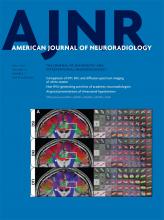Index by author
Lai, L.
- FELLOWS' JOURNAL CLUBAdult BrainYou have accessAtypical Presentations of Intracranial Hypotension: Comparison with Classic Spontaneous Intracranial HypotensionA.A. Capizzano, L. Lai, J. Kim, M. Rizzo, L. Gray, M.K. Smoot and T. MoritaniAmerican Journal of Neuroradiology July 2016, 37 (7) 1256-1261; DOI: https://doi.org/10.3174/ajnr.A4706
The authors evaluated the clinical records and neuroimaging of patients with spontaneous intracranial hypotension from September 2005 to August 2014. Patients with classic spontaneous intracranial hypotension (n = 33) were compared with those with intracranial hypotension with atypical clinical presentation (n = 8). There was no significant difference in dural enhancement, subdural hematomas, or cerebellar tonsil herniation. Patients with atypical spontaneous intracranial hypotension had significantly more elongated anteroposterior midbrain diameter compared with those with classic spontaneous intracranial hypotension, and shortened pontomammillary distance. In this population, patients with atypical spontaneous intracranial hypotension showed a more chronic syndrome compared with classic spontaneous intracranial hypotension, more severe brain sagging, lower rates of clinical response, and frequent relapses.
Lal, D.
- Head and Neck ImagingYou have accessThe Impact of Middle Turbinate Concha Bullosa on the Severity of Inferior Turbinate Hypertrophy in Patients with a Deviated Nasal SeptumC.M. Tomblinson, M.-R. Cheng, D. Lal and J.M. HoxworthAmerican Journal of Neuroradiology July 2016, 37 (7) 1324-1330; DOI: https://doi.org/10.3174/ajnr.A4705
Lee, C.-Y.
- EDITOR'S CHOICEAdult BrainOpen AccessMapping the Orientation of White Matter Fiber Bundles: A Comparative Study of Diffusion Tensor Imaging, Diffusional Kurtosis Imaging, and Diffusion Spectrum ImagingG.R. Glenn, L.-W. Kuo, Y.-P. Chao, C.-Y. Lee, J.A. Helpern and J.H. JensenAmerican Journal of Neuroradiology July 2016, 37 (7) 1216-1222; DOI: https://doi.org/10.3174/ajnr.A4714
The authors evaluated fiber bundle orientations from DTI and diffusional kurtosis compared with diffusion spectrum imaging as a criterion standard to assess the performance of each technique. DTI, diffusional kurtosis imaging, and diffusion spectrum imaging datasets were acquired during 2 independent sessions in 3 volunteers. While orientation estimates from all 3 techniques had comparable angular reproducibility, diffusional kurtosis imaging decreased angular error throughout the white matter compared with DTI. Diffusion spectrum imaging and diffusional kurtosis imaging enabled the detection of crossing-fiber bundles. They conclude that fiber bundle orientation estimates from diffusional kurtosis imaging have less systematic error than those from DTI.
Leonini, S.
- NeurointerventionYou have accessHemodynamic and Anatomic Variations Require an Adaptable Approach during Intra-Arterial Chemotherapy for Intraocular Retinoblastoma: Alternative Routes, Strategies, and Follow-UpE. Bertelli, S. Leonini, D. Galimberti, S. Moretti, R. Tinturini, T. Hadjistilianou, S. De Francesco, D.G. Romano, I.M. Vallone, S. Cioni, P. Gennari, P. Galluzzi, I. Grazzini, S. Rossi and S. BraccoAmerican Journal of Neuroradiology July 2016, 37 (7) 1289-1295; DOI: https://doi.org/10.3174/ajnr.A4741
Li, T.
- NeurointerventionOpen AccessMulticenter Prospective Trial of Stent Placement in Patients with Symptomatic High-Grade Intracranial StenosisP. Gao, D. Wang, Z. Zhao, Y. Cai, T. Li, H. Shi, W. Wu, W. He, L. Yin, S. Huang, F. Zhu, L. Jiao, X. Ji, A.I. Qureshi and F. LingAmerican Journal of Neuroradiology July 2016, 37 (7) 1275-1280; DOI: https://doi.org/10.3174/ajnr.A4698
Limperopoulos, C.
- Pediatric NeuroimagingOpen AccessBrain Injury in Neonates with Complex Congenital Heart Disease: What Is the Predictive Value of MRI in the Fetal Period?M. Brossard-Racine, A. du Plessis, G. Vezina, R. Robertson, M. Donofrio, W. Tworetzky and C. LimperopoulosAmerican Journal of Neuroradiology July 2016, 37 (7) 1338-1346; DOI: https://doi.org/10.3174/ajnr.A4716
Ling, F.
- NeurointerventionOpen AccessMulticenter Prospective Trial of Stent Placement in Patients with Symptomatic High-Grade Intracranial StenosisP. Gao, D. Wang, Z. Zhao, Y. Cai, T. Li, H. Shi, W. Wu, W. He, L. Yin, S. Huang, F. Zhu, L. Jiao, X. Ji, A.I. Qureshi and F. LingAmerican Journal of Neuroradiology July 2016, 37 (7) 1275-1280; DOI: https://doi.org/10.3174/ajnr.A4698
Liu, S.
- EDITOR'S CHOICEAdult BrainOpen AccessIron and Non-Iron-Related Characteristics of Multiple Sclerosis and Neuromyelitis Optica Lesions at 7T MRIS. Chawla, I. Kister, J. Wuerfel, J.-C. Brisset, S. Liu, T. Sinnecker, P. Dusek, E.M. Haacke, F. Paul and Y. GeAmerican Journal of Neuroradiology July 2016, 37 (7) 1223-1230; DOI: https://doi.org/10.3174/ajnr.A4729
Twenty-one patients with MS and 21 patients with neuromyelitis optica underwent 7T high-resolution 2D-gradient-echo-T2* and 3D-susceptibility-weighted imaging. An in-house-developed algorithm was used to reconstruct quantitative susceptibility mapping from SWI. Of the patients with MS, 19 (90.5%) demonstrated at least 1 quantitative susceptibility mapping–hyperintense lesion, and 11/21 (52.4%) had iron-laden lesions. No quantitative susceptibility mapping–hyperintense or iron-laden lesions were observed in any patients with neuromyelitis optica. The authors conclude that ultra-high-field MR imaging may be useful in distinguishing MS from neuromyelitis optica.
Liu, T.
- Adult BrainOpen AccessQuantitative Susceptibility Mapping in Cerebral Cavernous Malformations: Clinical CorrelationsH. Tan, L. Zhang, A.G. Mikati, R. Girard, O. Khanna, M.D. Fam, T. Liu, Y. Wang, R.R. Edelman, G. Christoforidis and I.A. AwadAmerican Journal of Neuroradiology July 2016, 37 (7) 1209-1215; DOI: https://doi.org/10.3174/ajnr.A4724
Luijten, P.R.
- NeurointerventionOpen AccessThinner Regions of Intracranial Aneurysm Wall Correlate with Regions of Higher Wall Shear Stress: A 7T MRI StudyR. Blankena, R. Kleinloog, B.H. Verweij, P. van Ooij, B. ten Haken, P.R. Luijten, G.J.E. Rinkel and J.J.M. ZwanenburgAmerican Journal of Neuroradiology July 2016, 37 (7) 1310-1317; DOI: https://doi.org/10.3174/ajnr.A4734








